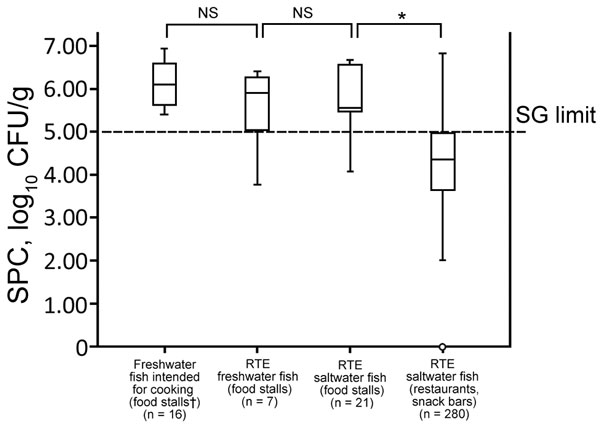Volume 23, Number 12—December 2017
CME ACTIVITY - Research
Group B Streptococcus Infections Caused by Improper Sourcing and Handling of Fish for Raw Consumption, Singapore, 2015–2016
Figure 1

Figure 1. SPCs for sliced fish samples collected from various eating establishments during investigation of group B Streptococcus infections, Singapore, 2015–2016. Dashed horizontal line indicates regulatory limit of Singapore for SPCs for ready-to-eat foods (<5 log10 CFU/g) (14). Top and bottom of boxes in plots indicate 25th and 75th percentiles, horizontal lines indicate medians, and whiskers indicate minimum and maximum values. *p<0.05. †Food stalls housed within larger eating establishments that include hawker centers, coffee shops, and eating houses. Open circle indicates an outlier. NS, not significant (p>0.05); RTE, ready to eat; SG, Singapore government; SPCs, standard plate counts.
References
- Joint news release between the Ministry of Health Singapore (MOH) and the Agri-Food and Veterinary Authority of Singapore (AVA) and the National Environment Agency (NEA). Update on investigation into group B Streptococcus cases. July 24, 2015 [cited 2016 Aug 10]. http://www.nea.gov.sg/corporate-functions/newsroom/news-releases/year/2015/month/7/category/food-hygiene/update-on-investigation-into-group-b-streptococcus-cases
- Tan S, Lin Y, Foo K, Koh HF, Tow C, Zhang Y, et al. Group B Streptococcus serotype III sequence type 283 bacteremia associated with consumption of raw fish, Singapore. Emerg Infect Dis. 2016;22:1970–3. DOIPubMedGoogle Scholar
- Rajendram P, Mar Kyaw W, Leo YS, Ho H, Chen WK, Lin R, et al. Group B Streptococcus sequence type 283 disease linked to consumption of raw fish, Singapore. Emerg Infect Dis. 2016;22:1974–7. DOIPubMedGoogle Scholar
- Tan K, Wijaya L, Chiew HJ, Sitoh YY, Shafi H, Chen RC, et al. Diffusion-weighted MRI abnormalities in an outbreak of Streptococcus agalactiae Serotype III, multilocus sequence type 283 meningitis. J Magn Reson Imaging. 2017;45:507–14. DOIPubMedGoogle Scholar
- Manning SD, Neighbors K, Tallman PA, Gillespie B, Marrs CF, Borchardt SM, et al. Prevalence of group B streptococcus colonization and potential for transmission by casual contact in healthy young men and women. Clin Infect Dis. 2004;39:380–8. DOIPubMedGoogle Scholar
- Public Health Agency of Canada. Streptococcus agalactiae: pathogen safety data sheet—infectious substances. April 30, 2012 [cited 2016 Aug 10]. http://www.phac-aspc.gc.ca/lab-bio/res/psds-ftss/streptococcus-agalactiae-eng.php
- Ballard MS, Schønheyder HC, Knudsen JD, Lyytikäinen O, Dryden M, Kennedy KJ, et al.; International Bacteremia Surveillance Collaborative. The changing epidemiology of group B streptococcus bloodstream infection: a multi-national population-based assessment. Infect Dis (Lond). 2016;48:386–91. DOIPubMedGoogle Scholar
- Phares CR, Lynfield R, Farley MM, Mohle-Boetani J, Harrison LH, Petit S, et al.; Active Bacterial Core surveillance/Emerging Infections Program Network. Epidemiology of invasive group B streptococcal disease in the United States, 1999-2005. JAMA. 2008;299:2056–65. DOIPubMedGoogle Scholar
- Foxman B, Gillespie BW, Manning SD, Marrs CF. Risk factors for group B streptococcal colonization: potential for different transmission systems by capsular type. Ann Epidemiol. 2007;17:854–62. DOIPubMedGoogle Scholar
- Delannoy CM, Crumlish M, Fontaine MC, Pollock J, Foster G, Dagleish MP, et al. Human Streptococcus agalactiae strains in aquatic mammals and fish. BMC Microbiol. 2013;13:41. DOIPubMedGoogle Scholar
- Ip M, Cheuk ES, Tsui MH, Kong F, Leung TN, Gilbert GL. Identification of a Streptococcus agalactiae serotype III subtype 4 clone in association with adult invasive disease in Hong Kong. J Clin Microbiol. 2006;44:4252–4. DOIPubMedGoogle Scholar
- Kalimuddin S, Chen SL, Lim CTK, Koh TH, Tan TY, Kam M, et al. Singapore Group B Streptococcus Consortium. 2015 epidemic of severe Streptococcus agalactiae ST283 infections in Singapore associated with the consumption of raw freshwater fish: a detailed analysis of clinical, epidemiological and bacterial sequencing data. Clin Infect Dis. 2017;64(Suppl_2):S145–52.
- Joint news release between the Agri-Food and Veterinary Authority of Singapore (AVA) and the Ministry of Health Singapore (MOH) and the National Environment Agency (NEA). Freshwater fish banned from ready-to-eat raw fish dishes. December 5, 2015 [cited 2016 Aug 10]. http://www.nea.gov.sg/corporate-functions/newsroom/news-releases/freshwater-fish-banned-from-ready-to-eat-raw-fish-dishes
- Agri-Food and Veterinary Authority of Singapore. Sale of food act, chapter 283, section 56 (1), food regulations. December 20, 2016 [cited 2017 Jan 9]. http://www.ava.gov.sg/legislation
- British Columbia Centre for Disease Control. Food processing plants: guideline for live retail fish holding system. November 2013 [cited 2016 Aug 17]. http://www.bccdc.ca/resource-gallery/Documents/Educational%20Materials/EH/FPS/Food/RetailFishHoldingTankGuidelines_Nov2013trs.pdf
- Da Cunha V, Davies MR, Douarre PE, Rosinski-Chupin I, Margarit I, Spinali S, et al.; DEVANI Consortium. Streptococcus agalactiae clones infecting humans were selected and fixed through the extensive use of tetracycline. Nat Commun. 2014;5:4544. DOIPubMedGoogle Scholar
- Mehershahi KS, Hsu LY, Koh TH, Chen SL. Complete genome sequence of Streptococcus agalactiae serotype III, multilocus sequence type 283 strain SG-M1. Genome Announc. 2015;3:e01188–15.PubMedGoogle Scholar
- Abuseliana AF, Daud HH, Aziz SA, Bejo SK, Alsaid M. Pathogenicity of Streptococcus agalactiae isolated from a fish farm in Selangor to juvenile red tilapia (Oreochromis sp.). J Anim Vet Adv. 2011;10:914–9. DOIGoogle Scholar
- Liu G, Zhang W, Lu C. Complete genome sequence of Streptococcus agalactiae GD201008-001, isolated in China from tilapia with meningoencephalitis. J Bacteriol. 2012;194:6653. DOIPubMedGoogle Scholar
- Wang R, Li L, Huang Y, Luo F, Liang W, Gan X, et al. Comparative genome analysis identifies two large deletions in the genome of highly-passaged attenuated Streptococcus agalactiae strain YM001 compared to the parental pathogenic strain HN016. BMC Genomics. 2015;16:897. DOIPubMedGoogle Scholar
- Martins C, Eding EH, Verdegem MC, Heinsbroek LT, Schneider O, Blancheton J-P, et al. New developments in recirculating aquaculture systems in Europe: a perspective on environmental sustainability. Aquacult Eng. 2010;43:83–93. DOIGoogle Scholar
- Little D, Edwards P. Integrated livestock-fish farming systems. Rome: Food and Agriculture Organization of the United Nations; 2003 [cited 2017 Aug 15]. http://www.fao.org/docrep/006/y5098e/y5098e00.htm
- International Commission on Microbiological Specifications for Foods. Micro-organisms in foods 2: sampling for microbiological analysis; principles and specific applications. 2nd ed. 1986 [cited 2016 Aug 11]. http://www.icmsf.org/pdf/icmsf2.pdf
- Food and Drug Administration. Bad bug book: foodborne pathogenic microorganisms and natural toxins. 2nd ed. Silver Spring (MD): The Administration; 2012.
- Chau ML, Aung KT, Hapuarachchi HC, Lee PSV, Lim PY, Kang JSL, et al. Microbial survey of ready-to-eat salad ingredients sold at retail reveals the occurrence and the persistence of Listeria monocytogenes Sequence Types 2 and 87 in pre-packed smoked salmon. BMC Microbiol. 2017;17:46. DOIPubMedGoogle Scholar
1These authors contributed equally to this article.